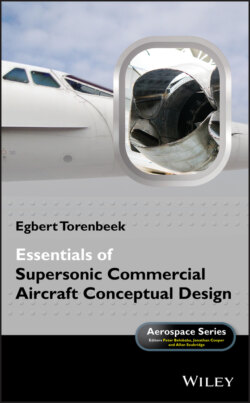Читать книгу Essentials of Supersonic Commercial Aircraft Conceptual Design - Egbert Torenbeek - Страница 15
1.5 European Supersonic Research Program
ОглавлениеSimilar to the US studies during the 1990s, the European industry indicated a market potential for an aircraft substantially larger and with longer longer range than the Concorde, linking the world's major cities. In 1990 the companies Aerospatiale, British Aerospace, and Deutsche Airbus launched a three‐year study into the technical feasibility of a second‐generation supersonic transport successor of the Concorde. In 1994 the Supersonic Research Program (ESRP) was established to undertake the research and technology development required to produce the enabling technologies for second generation supersonic commercial transport. The ESRP was supported by a common reference configuration known as the European Supersonic Commercial Transport (ESCT). Its main characteristics are compared with those of the Concorde and the Tu 144 in Table 1.1.
Table 1.1 Characteristics of the first generation supersonic transport and the ESCT
| Concorde | Tu‐144 | ESCT | ||
| Maximum take‐off mass | tonnes | 185 | 200 | 320 |
| Range | km | 6,200 | 3,500 | 10,000 |
| Span | m | 25.6 | 28.8 | 42.0 |
| Length | m | 61.7 | 65.7 | 89.0 |
| Passengers | 90 | 150 | 250 | |
| Supersonic cruise Mach number | 2.0 | 2.35 | 2.0 |
Also similar to the US studies during the 1990s, the European industry indicated a market potential for an aircraft substantially larger and with longer range than the Concorde, linking the world's major cities. The ESCT could be economically viable and environmentally friendly, in particular due to its capacity to carry 250 passengers over distances up to 10,000 km and its much improved take‐off field performance compared to the Concorde. Figure 1.5 depicts a three view drawing of one of the designs studied in the framework of the ESCT.
Due to the widely divergent requirements at supersonic and low‐subsonic flight conditions it is unavoidable that the engines for the ESCT will have a variable geometry and/or operating cycle. Figure 1.6 depicts the mid tandem fan (MTF) power plant selected for the ESCT, generated by Roll‐Royce and SNECMA in cooperation. This engine concept is equipped with a secondary fan coupled to the secondary body. During take‐off and climb the air enters the engine via auxiliary inlets. This double flow path allows very low specific fuel consumption during subsonic operation with a bypass ratio of 12 at Mach 0.8 and an exhaust velocity less than 400 m s−1 at the converging nozzle outlet. Auxiliary inlets are closed during the supersonic cruise at Mach 1.6 and the variable inlet mid‐fan guide vanes reduce frontal airflow to the bypass duct. The bypass ratio is then 2.5 and the exhaust jet velocity 620 m s−1.
